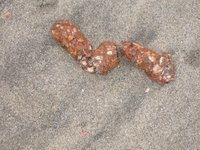I became fascinated with scat during a ‘tracking’ experience at Wilderness Awareness School in Duvall, WA. We were learning to identify local animals by their tracks, hair deposits on brush, and scat, if we were lucky. That summer, I was honored to participate in a wolf-tracking expedition in Idaho, where scat played an enormous role in following these magnificent creatures.

Who would have thought I would be fortunate enough to come across sea otter scat. The stuff we found on the cove beach within the West parking lot area was amazing. Some was ‘fluffy’ and filled with crab and clam shells and probably innkeeper worms. Others were more canine-like, perhaps belonging to local foxes – also filled with crabs. There were, as well, several piles of orangish oatmeal-like blobs, dark-colored ooze and oops ~! diarrhea!

The question is, which scat sample came from which animal. We could narrow down the donators by observing tracks in the sand to harbor seals, sea otter and possibly fox. Peter shot a few good photos of tracks along side the GPS unit, for size comparison. Now it’s up to the scientists – “scatologists” - to decipher the contents of the samples we collected. Therein they will discover the species digested, pollution levels and possibly DNA identification. Cool!

Anna shared her poop photos of African animals. Puts a new curve on those of us who are naturally drawn to the other end of “what goes in …. “.
Elizabeth Gates
Monterey Marine mammals – Team 2
Aug. 25, 2006
tracks on W. beach/harbor seal?
No comments:
Post a Comment